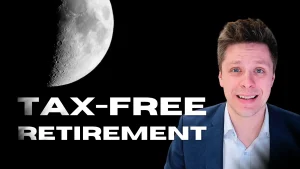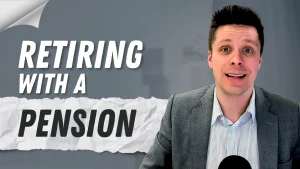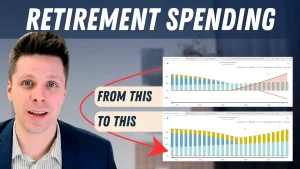[vc_row][vc_column][vc_video link=”https://youtu.be/NHxPmnG3-dA” css=”.vc_custom_1679067241140{padding-top: 20px !important;padding-bottom: 20px !important;}”][/vc_column][/vc_row][vc_row][vc_column][vc_column_text]RRSPs are a popular retirement savings account, but it may be advisable to draw them down aggressively once retired. Here are 3 reasons to aggressively drawdown your RRSPs.
-
RRSP Tax Bomb
There are many people out there who hate RRSPs. I often hear stories like, “My parents had money in RRSPs, and when they passed away, the government took half their money.”
Yes, that can happen, but it can be avoided with proper planning.
(Here is a deeper dive into the RRSP Tax Bomb)
So what’s the issue?
Here are the combined Manitoba and Federal tax rates. We have a progressive tax system, so as we can see, higher incomes are taxed at a higher rate.[/vc_column_text][/vc_column][/vc_row][vc_row][vc_column][dt_fancy_image image_id=”10053″ width=”1200″ css=”.vc_custom_1679067714617{padding-top: 20px !important;padding-bottom: 20px !important;}”][vc_column_text]
Source: www.canada.ca/en/services/taxes/income-tax/personal-income-tax.html
Let’s say we have Jim & Rose, and they each have $500,000 in their RRSPs. If Jim passes away, his $500k would roll over to Rose’s RRSP tax-free, and she would now have $1,000,000 in her own RRSP.
Once Rose passes away, the entire value of her RRSP will be added to her income in the year of her death. Assuming she still has $1 million in her RRSP, she’ll be in the top tax bracket and paying over 50% tax on most of her income. Not fun!
Even if Rose names her kids as beneficiaries, there’s no way for her estate to get around this tax bill.
How to avoid The Tax Bomb
Jim and Rose can draw down their RRSPs aggressively today to avoid paying such a large tax bill at death.
If both of their incomes are $60,000 per year, they would each be in the 33.25% tax bracket. If they each withdrew an extra $19k from their RRSPs, their taxable incomes would rise to $79,000 each. They would remain in the same tax bracket and pay a whole lot less today compared to if they both passed away.
Even if Jim and Rose don’t need the funds from the RRSP, they can use the cash to top up their Tax-Free Savings Account or to invest in a joint non-registered account where it can grow more efficiently.
-
OAS Clawback
The second reason to draw down your RRSPs aggressively is to avoid the OAS clawback.
At age 65, most Canadians take their Old Age Security pension, which currently pays just over $687 per month, assuming you receive the maximum payout.
To receive the maximum, you must have lived in Canada for 40 years after age 18.
However, if you are receiving your OAS pension and your net income is above $86,912, your OAS pension will be reduced by $0.15 for every dollar above the amount.
For example, if you made $100,000. Your OAS pension would be reduced by $163 per month ($100,000-$86,912*$0.15/12).
Avoiding O.A.S Clawback
Let’s say Rick is 62 and has money in his RRSP but doesn’t need the funds, so the account continues to grow in value over the years.
Eventually, at age 71, Rick is forced to convert his RRSP to a RRIF. Once the RRSP is in the RRIF, there is a minimum amount that Rick needs to withdraw every year starting at age 72. As it currently stands, he would need to withdraw 5.40% of his RRIF at 72.
If Rick has $1 million in his RRIF, he would need to withdraw $54,000. If he already has other income of $50,000, his total income would now be $104,000. He would unnecessarily be losing a portion of his OAS pension.
Rather than waiting until 72 to make withdrawals, Rick would be better served to make yearly withdrawals along the way. By doing so, his mandated withdrawals at 72 would be lower as there would be less money in the account. He could potentially get around the OAS Clawback if the mandated withdrawals are low enough.
-
Personal Care Homes
As much as we don’t want to think about it, we may end up in a personal care home one day. Fair or not, the cost of living in a Manitoba Health personal care home is based on your income.
And just because you pay more than the person in the room beside you doesn’t mean you’ll receive steak dinners every night. Your services will actually be the exact same.
Cost of Personal Care Home
For an individual in Manitoba, if your net income is below $19,160, you will pay the lowest daily rate of $39.90 per day. As your net income rises, so does your daily cost, which maxes out at $96.40 per day once your net income is above $39,746.
As you can see, someone with a high income is paying nearly three times as much as someone with a low income for the exact same services.
Since there’s no advantage to having a high income once in a care home, it’s beneficial to keep income as low as possible to pay less for your care.
There isn’t much you can do if you’re receiving pension income (Work pension, CPP, OAS), but you’ll want to keep your withdrawals from your registered savings accounts as low as possible once in a care home.
The best way to do this is to aggressively withdraw funds from your RRSP or RRIF before you enter a care home.[/vc_column_text][/vc_column][/vc_row]





